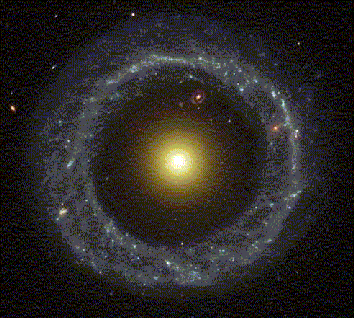Hubble's view of Hoag's Object
Click on image for full size
NASA and the Hubble Heritage Team (STScI/AURA
New Pictures of Hoag’s Object!
News story originally written on September 12, 2002
The Hubble Space Telescope has recently taken some exciting pictures of Hoag’s Object, a mysterious galaxy 600 million light years from Earth.
The galaxy was named after Art Hoag, the astronomer who found it in 1950. Located in the constellation Serpens, Hoag’s Object is about the size of our galaxy but it has an unusual shape with a blue ring of young stars and a yellow center of older stars. It is so unusual, in fact, that Art Hoag did not know it was a galaxy when he first found it.
Hoag’s Object is unlike other ring shaped galaxies, which often form by collision with another galaxy, because it shows no signs of collision. Astronomers suspect that the outer ring of stars was formed two to three billion years ago when a galaxy passing nearby left young stars behind.
Last modified September 12, 2002 by Lisa Gardiner.
You might also be interested in:

The Hubble Space Telescope (HST) was one of the most important exploration tools of the past two decades, and will continue to serve as a great resource well into the new millennium. The HST found numerous
...more
It was another exciting and frustrating year for the space science program. It seemed that every step forward led to one backwards. Either way, NASA led the way to a great century of discovery. Unfortunately,
...more
The Space Shuttle Discovery lifted off from Kennedy Space Center on October 29th at 2:19 p.m. EST. The weather was great as Discovery took 8 1/2 minutes to reach orbit. This was the United States' 123rd
...more
A moon was discovered orbiting the asteroid, Eugenia. This is only the second time in history that a satellite has been seen circling an asteroid. A special mirror allowed scientists to find the moon
...more
Will Russia ever put the service module for the International Space Station in space? NASA officials want an answer from the Russian government. The necessary service module is currently waiting to be
...more
A coronal mass ejection (CME) happened on the Sun early last month. The material that was thrown out from this explosion passed the ACE spacecraft. The SWICS instrument on ACE has produced a new and very
...more
J.S. Maini of the Canadian Forest Service called forests the "heart and lungs of the world." This is because forests filter air and water pollution, absorb carbon dioxide, release oxygen, and maintain
...more















